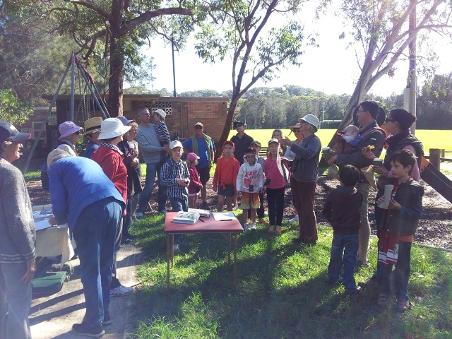May 26 - June 1, 2013: Issue 112 |
Community News - May 2013
Pittwater Camera Clubs Shirley Fealy Creative Trophy - 2013
Pittwater Camera Club President Peter Squires won the clubs Creative Competition this year for the Shirley Fealy Trophy. " Waiting for The Tide To Go Out" is a stunning example of Peters photographic skill married to his understanding of Adobe Photoshop possibilities.
The club meets on alternate Mondays at the BYRA Hall at Bayview at 7.45pm and visitors are always welcome.
See website for details: pittwatercameraclub.org.


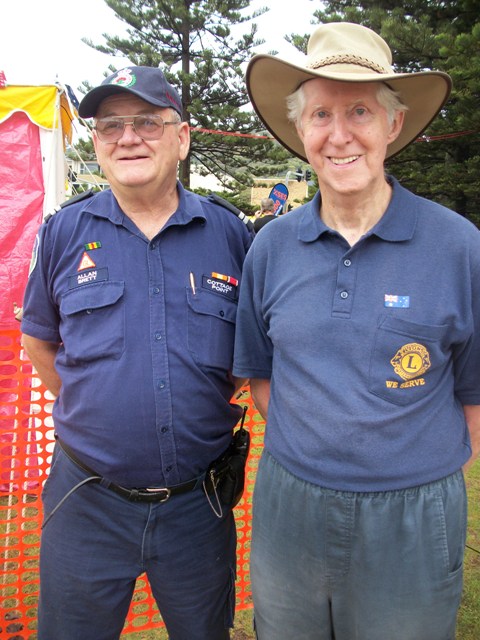 AWARDS NIGHT TO HONOUR RFS
AWARDS NIGHT TO HONOUR RFS
Rural Fire Service volunteers from the Warringah Pittwater District were honoured at an awards presentation on Thursday 23 May at Bayview. Hosted by Pittwater Council the event will took place at Bayview Golf Club. Pittwater Mayor Jacqui Townsend said the awards recognised the invaluable contribution that the RFS volunteers made to the community.
“Many of these individuals literally put their lives on the line in the course of their work,” she said. “This is a chance to acknowledge and reward their years of diligent service as well as those members who go above and beyond expectations,” said Mayor Townsend.
RFS Superintendent Craig Geddes said that the evening was about commending the award recipients on their dedication, commitment and service to the local community over many years.
“We will be awarding 47 medals to 45 worthy recipients. These volunteers between them have accumulated an extraordinary 761 years of service! Sixteen recipients will receive national medals on the night – these are for members who go beyond what is expected of active members within the brigade,” said Supt. Geddes “In addition we will acknowledge those long-serving members who have dedicated between ten and over forty years of service.”
One of the recipients was Allan Brett, who will receive a long service medal for 42 years service, having joined the Cottage Point Brigade in 1971. Allan is also the chair of the Pittwater Australia Day organising committee, which has been running the Australia Day Breakfast on the Beach since 1988.
Photo: Allan Brett of Cottage Point RFS and Frank Spencer of Avalon Lions Club by A J Guesdon, 2012 Australia Day.
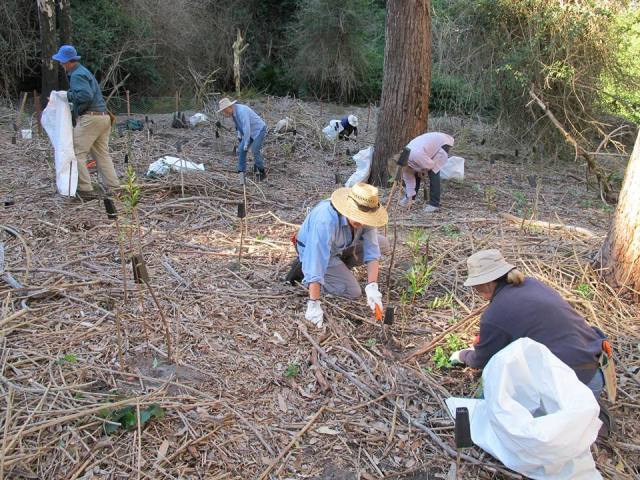 Pittwater Environmental Foundation
Pittwater Environmental Foundation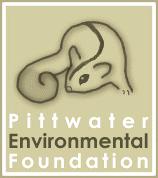 To right is a photo from our second bushcare day at Mullet Creek, near the Irrawong waterfall. Wallabies are more determined than we thought! But lots of plants are growing well and we got out a lot of horrible Turkey Rhubarb.
To right is a photo from our second bushcare day at Mullet Creek, near the Irrawong waterfall. Wallabies are more determined than we thought! But lots of plants are growing well and we got out a lot of horrible Turkey Rhubarb.
The third Sunday of each month is our work day, starting at 1pm. Next day will be June 16. Learn more about PEF HERE
Vital Community Meetings You Can Attend – Proposed Amalgamation of Councils and the White Paper
In recent months we have run information regarding proposed changes that directly affect you and links to these documents and where you may contribute your views. The proposal to amalgamate Pittwater with other councils is one of these and could see us become not only one of the most recent new Councils but also one of the shortest lived ones. The second is the NSW Department of Planning & Infrastructure - White Paper which may be finding an inappropriate structure being constructed in an inappropriate place and you having no say on this.
There are two meetings Pittwater Council is inviting all to attend the first of these being May 28th, Tuesday week, at Mona Vale Memorial Hall. Full details from Pittwater Council’s website are below. Please attend!!
Council Reform - the proposal to amalgamate Pittwater
Reform 1 - NSW Department of Planning & Infrastructure - White Paper
Planning laws in NSW will be replaced by a new system aimed at fast-tracking development. The White Paper ‘A New Planning System for NSW’ (released April 2013) is on exhibition for public comment until 28 June 2013. The state government intends to bring in these changes by the end of this year.
The main changes are:
Putting development and growth ahead of the environment and the character of neighbourhoods
80% of development applications will not be notified to neighbours
Developments such as 20 townhouses or units can be approved without notifying neighbours
Residential zones with a wide range of uses, meaning in theory a factory could be built next to a house
Ministerial power to override local planning decisions
Minimal local representation on a regional board that will decide future planning for Pittwater.
Tuesday 28 May - Mona Vale Memorial Hall, Park Street Mona Vale between 6.30pm and 8pm.
Pittwater Council is hosting a forum on the issue with local Councillors. You do not need to register to attend.
Other important dates for your diary
Monday 24 June 2013 - 6.30pm - Mona Vale Memorial Hall, Park Street, Mona Vale
Pittwater Council is preparing a detailed submission to the NSW Department of Planning & Infrastructure outlining its objections to the proposed changes. The Council meeting on 24 June will consider Pittwater’s submission on the White Paper. Residents are welcome to attend.
Friday 28 June 2013
Public submissions close on the White Paper planning reforms. To make a comment visit www.planning.nsw.gov.au and follow the links to make an online submission on the "A New Planning System for NSW - White Paper".
Reform 2 - Future Directions for NSW Local Government report (released April 2013)
The NSW government has commissioned an independent panel to look into the future of local councils in the state. The three-member Independent Local Government Review Panel has been examining NSW councils since July 2012. Its latest report - Future Directions for NSW Local Government - was released in April 2013. A final report will be delivered to the government by September 2013, after which the NSW government will consider its position on local government reform. We believe that the September report will not be made public.
The Panel’s Future Directions report released last month proposes the following changes:
The number of Sydney councils be reduced to 15 mega-councils
Amalgamate Pittwater with Warringah and Manly Councils or create a ‘county council’ for the northern beaches
Streamline rate pegging so that the new mega-councils can increase rates by an extra 3% over four years.
Given that Pittwater would no longer have a council representing the community’s interests, Pittwater Council is opposed to this proposal.
At its meeting on 6 May 2013 the Council resolved unanimously:-
"That Council remains committed to a strong independent Pittwater Council providing local representation and delivering local services to the people of Pittwater.
That Council is opposed to the Panel option of either amalgamating with Manly and Warringah Councils or combining as a strong County Council as outlined in the Future Directions paper."
Progress so far on the Local Government Review
The Independent Local Government Review Panel is seeking public feedback on the recommendations of the Future Directions report until 28 June 2013.
Tuesday 28 May 2013
Pittwater Council is hosting a community forum to discuss the issue at Mona Vale Memorial Hall, Park Street Mona Vale between 6.30pm and 8pm. You do not need to register to attend this forum.
Tuesday 4 June 2013
The Independent Local Government Review Panel is holding a Public Hearing between 5pm and 7pm at Warringah Council Chambers, 725 Pittwater Road Dee Why.
You must pre-register to speak at this meeting. If you wish to address the Panel for 5 minutes complete this form through the following link www.localgovernmentreview.nsw.gov.au and email toinfo@localgovernmentreview.nsw.gov.au You can attend the meeting but not speak without pre-registering.
Pittwater Council is arranging buses to assist members of the public to attend the public hearing. Buses will depart at 4pm on Tuesday 4 June from Warriewood Valley Sportsground, Jacksons Road opposite Warriewood Square Shopping Centre.
Book a place online or phone 9970 1157.
Other important dates for your diary
Monday 24 June 2013- 6.30pm Mona Vale Memorial Hall Park Street Mona Vale
Pittwater Council is preparing a detailed submission to the Independent Local Government Review Panel outlining its objections to the proposed reforms. The Council meeting on 24 June will consider Pittwater’s submission to the Panel. Residents are welcome to attend.
Friday 28 June 2013
Public submissions close on the Panel's recommended reforms of local councils. To make a comment visitwww.localgovernmentreview.nsw.gov.au and follow the links to Have Your Say to make an online submission on the Independent Local Government Review Panel Paper.
See: http://www.pittwater.nsw.gov.au/reform
Landmark study marks 30-year milestone - Media release - 20 May 2013
Understanding childhood temperament and its impact on behaviours in adulthood has been highlighted in a new report about the Australian Temperament Project (ATP). Australian Institute of Family Studies Director, Professor Alan Hayes said the report draws together key findings from the study, which has been tracking the progress and wellbeing of a group of people and their families for 30 years.
"This flagship study has been very important in helping us - as parents and researchers - to understand the links from early childhood development to a range of things such as teenage alcohol use, risky driving behaviours and civic participation,' he said. "The ATP, which began in 1983 has tracked the development of more than 1,000 Victorian children from infancy to their late twenties. It is one of the longest running social studies in Australia and one of the few in the world with information on three generations of family members - the young people, their parents and now the young people's children.
"The ATP was among the first in Australia to show a link between parental attitudes to alcohol use and teenagers' drinking habits. The study has also led the way in moving beyond solely focusing on things that can go wrong in people's lives to also look at what contributed to healthy development.'
Professor Hayes said key findings of the Australian Temperament Project include:
Infancy / Early childhood
Temperament is relatively stable over time, with many children showing small changes but very few children changing radically in their temperament.
More 'difficult' infant temperamental characteristics can lead to behavioural and emotional adjustment problems in early childhood and beyond.
Temperament can be modified through experiences such as the style of parenting. Shy infants were more likely to overcome their shyness if parents were warm, positive and understanding.
Primary School years
The seeds of many school-aged problems could be seen in early childhood. Children with difficult temperament traits or emerging behaviour problems were particularly vulnerable to later difficulties.
It is possible for children to recover from early learning problems. Boys in particular were more likely to recover if they did not have other problems; had good thinking skills and their families were reasonably well-off.
Adolescence
Anxiety and depression are common problems in adolescence and parents may notice symptoms from early childhood.
Shyness, irritability and troubles with peers or parents may increase the risk of young people experiencing ongoing problems with anxiety or depression.
Females are more likely to experience anxiety and depression over adolescence and early adulthood.
Early identification and treatment of children with anxiety or depression may reduce the likelihood of such problems becoming entrenched.
Children with high anxiety or depression may be more likely to overcome their symptoms if they develop good social skills, have better parents and peer relationships and have more positive school experiences.
Genetic factors appear to increase the risk of anxiety and depression for some people, along with a range of other influences.
Most adolescents do not engage in high levels of antisocial behaviour and for those who do it is often for a short time.
Heavy alcohol use is quite common in adolescent years but not all heavy use results in a range of short-term harms.
Early Adulthood
Young people show evidence of positive development when they are well adjusted to society, are responsible and empathetic in their social relationships and feel satisfied with the direction that their life is taking.
Many young adults engage in risky driving on an occasional basis but only a small number frequently take risks when driving. This group can be distinguished from other drivers from mid-childhood on, by their display of more difficult temperament, higher rates of behaviour problems and lower social skills.
Risky drivers are more likely to engage in other risky behaviours, such as antisocial behaviour and drug use.
Most parents share close relationships with their sons or daughters over the transition from late adolescence to early adulthood but the nature of their role changes with many moving away from providing practical support to taking on a more advisory role.
The Australian Temperament Project is a joint project between the Australian Institute of Family Studies, the Royal Children's Hospital, the University of Melbourne and Deakin University.
Read The Australian Temperament Project: The first 30 years

The Newport Breakers Rugby Club is calling out to former players, supporters and community members to come forward with photos of Porters Reserve as they prepare to celebrate the clubs 50th birthday. The club has come a long way from its humble beginnings in 1963, when a former cow paddock turned rubbish tip was bulldozed to make way for a rugby field. Few of those early pioneers would have envisaged the legacy that they were creating for the northern beaches community. The Newport Junior Rugby club today is one of the largest in the Southern Hemisphere and comprises over 600 players with teams from U6’s to U17’s. The Newport Senior club, ‘The Breakers” compete in Suburban Rugby’s 2nd Division and field 5 senior sides including colts U21’s team and have over 120 registered players.
To celebrate this important milestone, Newport plans to celebrate its 50th year in style with a full calendar of events locked in throughout the season. Activities such as Back to Newport Day, the ever popular Ladies Day and Family days including children’s rides are all pencilled in to the celebrations.
Newport Breakers President Steve Hansen says “this year is obviously an important year for the club as we celebrate the big 50; we have focussed strongly on off season player recruitment which has resulted in swag of exciting new talent to the club”. Hansen said the club goals were “to better the 2 premierships achieved last year by our Colts and 4th grade sides, with a particular focus on achieving higher grade silverware”.
As for Porters Reserve, it starts the 50th year celebrations in tremendous condition. Newport have just completed upgrades to the ground with a complete resurface of Porters Reserve, new lights for training and continuing upgrading of the clubhouse and the change sheds will ensure the local players have the best facilities . Mr Hansen concludes “we’d particularly like to acknowledge the financial efforts of both Pittwater Council and the Newport Junior Rugby Club who have joined with us to achieve what is arguably the best rugby oval in Sydney”.
Anyone with photos from the 60’s and 70’s of Porters Reserve or old Newport rugby photos is kindly asked to email them to secretary@newportrugby.com.au
May 19 - 25, 2013: Issue 111
Southern Cross Wildlife Care - May 2013 Critters of the Month - Theodore and Blossom - Orphaned babies- By Lynleigh Grieg
Ringtail possums are - in my opinion - one of the cutest Australian animals! They are smaller than brushtail possums and have a long prehensile tail with a distinctive white section near the tip. They eat native foliage, native flowers and fruit. They are marsupials because they carry their young in pouches.
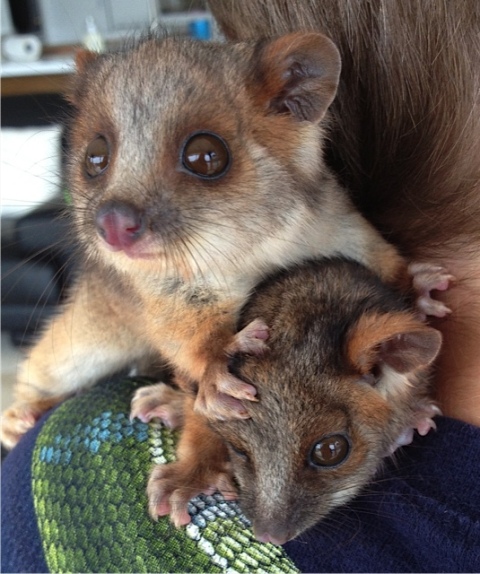 Meet Theodore (left) and Blossom (bottom) - “Outta my way, I want the camera to capture my good side...!”
Meet Theodore (left) and Blossom (bottom) - “Outta my way, I want the camera to capture my good side...!”
These two adorable ringtail babies came into care with Sydney Wildlife in February of this year. Theodore came riding into someone’s house, clinging to the neck of their dog! His mum was never found. Blossom’s mum was killed by a cat.
They were both about 65 grams when they came into care. At this weight, the babies require around-the-clock care! 4-hourly feeds day and night and artificial heat. They are put into little woollen pouches, lined with cotton fabric inserts. These mimic their mum’s pouch. The babies are always ‘buddied’ together with others of similar weights.
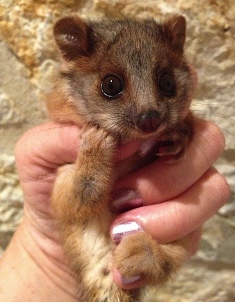 Theodore has always been very ‘clingy’. He never wanted to let go of me after his feeds and refused to go back into his basket...! You can see his little claws wrapped tightly around my fingers.
Theodore has always been very ‘clingy’. He never wanted to let go of me after his feeds and refused to go back into his basket...! You can see his little claws wrapped tightly around my fingers.
Blossom, on the other hand, was happy to be popped back into her knitted pouch and cuddle up in her favourite fluffy blanket. I think the ‘fur’ reminded her of her mum...
As the babies get bigger and bigger, they graduate from pouches to something called a ‘drey’. Ringtails build these 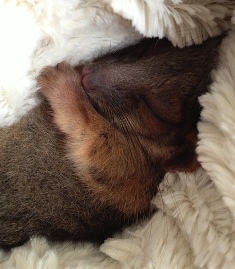 dreys or nests in the wild using all sorts of twigs, foliage and grasses. These babies will eventually be released into the wild in their drey. As they grow, they are also moved from a tiny basket to a big cage and eventually into an outdoor aviary.
dreys or nests in the wild using all sorts of twigs, foliage and grasses. These babies will eventually be released into the wild in their drey. As they grow, they are also moved from a tiny basket to a big cage and eventually into an outdoor aviary.
Blossom and Theodore have been growing week by week and are now big enough to be in a big outdoor aviary. As soon as they are able to lap their milk independently, we carers become completely ‘hands-off’. Their milk, foliage and fruit 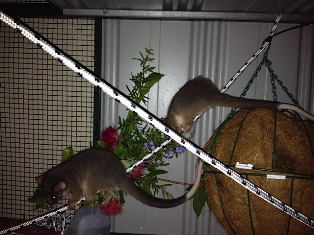 is placed into the aviary whilst they are asleep during the day. This de-humanises them and teaches them not to rely on us for their survival.
is placed into the aviary whilst they are asleep during the day. This de-humanises them and teaches them not to rely on us for their survival.
Theodore and Blossom are likely to be released in a few weeks’ time.
If you would like to keep our wonderful ringtails safe, please remember:
1. keep your cats indoors at night
2. drive very carefully at night in case they are on the road
3. try not to spray poisonous substances on your native plants
New $12 million Rehabilitation Unit For Mona Vale Hospital -13 May 2013
Member for Pittwater Rob Stokes today announced ADCO Constructions has been awarded the tender to construct Mona Vale Hospital’s new $12 million rehabilitation unit.
This state of the art facility will be co-located and fully integrated with the hospital’s existing rehabilitation and assessment unit and will expand the range and quality of services available to the community.
Once completed the new unit will assist patients recovering function or abilities following the onset of disease or injury and will include:
• A mix of single and two-bed rooms, • Multi-function spaces for activities and daily living exercise, • Gymnasium, • Group therapy spaces, • Lounge and dining areas, • Outdoor therapy areas
“This is the largest capital works project seen at Mona Vale Hospital in decades,” Rob Stokes said today.“This project forms part of the ongoing redevelopment of Mona Vale Hospital and will provide a huge boost to our community’s health services.
“This state of the art facility will incorporate the latest in building design and promote best practice techniques in rehabilitation medicine.
“The completed project will also include additional car parking spaces - which are vital as Mona Vale Hospital continues to expand.
“Early works for the project are well underway, including excavation for a new car park and the laying of new stormwater drains.
“Construction will begin this month and the new unit is expected to be open in mid-2014,” Rob Stokes said.
April 28 - May 4, 2013: Issue 108
Press release in response to the "Future Directions for NSW Local Government Paper April 2013".
From: People for Pittwater, 25th April 2013
The strongly held view of People for Pittwater (PFP) is that Pittwater must be retained as a LGA and that the way forward for Northern Beaches Councils is close collaboration through SHOROC on regional issues, combined purchasing to ensure economies of scale and the development of shared services. This model ensures that community remains at the centre of local government while the Region has the economic advantages of close collaboration.
The "tidying up" of the Northern Beaches advocated in the latest document from the review panel shows a total disregard for the history, heritage and sense of communities on the Northern Beaches.
Pittwater was founded after a community campaign to overcome what was seen as a neglect of our area by Warringah Council at that time. Pittwater Council is a financially viable and successful council supported by the overwhelming majority of our community.
The latest effort from the review panel advocates a return "the bad old days". For Pittwater the proposal for one council on the Northern Beaches means an erosion of our local identity. It will mean a loss of service levels for the residents of Pittwater. A bigger council will inevitably centralise services around the main centre -instead of being spent in Pittwater our rates will disproportionately go to support the development of the Dee Why Town Centre, the Warringah Aquatic Centre and other projects only marginally used by our community. Money now spent in Pittwater will be spent elsewhere on the Northern Beaches.
Bigger councils inevitably deal with bigger businesses. Small businesses not only in Pittwater but on the Northern Beaches as a whole are likely to be negatively affected by any merger. The Panel is suggesting the kind of amalgamation process which has proved totally unsuccessful and disruptive recently in QLD where four council areas have voted to de-amalgamate after being forced to amalgamate. In Noosa the vote was 80% in favour of de-amalgamation.
Pittwater is a successful and financially viable council supported overwhelmingly by our community. We must not become part of a messy and disruptive process when we already have something which works well and shows the way forward.
PFP notes the State Government position that there will be no forced amalgamations. PFP undertakes to campaign strongly against these amalgamation proposals which show a shameful disregard for our community and heritage.
Harvey Rose (Co-convenor PFP)
Future Directions for NSW Local Government Paper April 2013 at: HERE (PDF).
Australian Sailing Team Wins Gold - Saturday Night our time - Hyres, France
At 10pm AEST Tom Burton of the Australian Sailing Team won a gold medal in the Laser class at the ISAF Sailing World Cup in Hyeres. Tom was 4th and 6th in the two medal races to finish 9 points ahead of Robert Scheidt. Fellow Aussie Ryan Palk finished 8th.
Tom is part of the Objective Australia Youth America's Cup team. Also competing at Hyres are Pittwater sailors, PBSC and RPAYC's Jason Waterhouse (skipper of the Objective Australia team) and Lisa Darmanin. Jason will be making his Nacra 17 debut at ISAF Sailing World Cup Hyeres with cousin Lisa Darmanin. This duo won the ISAF Youth Worlds multihull gold in 2009.
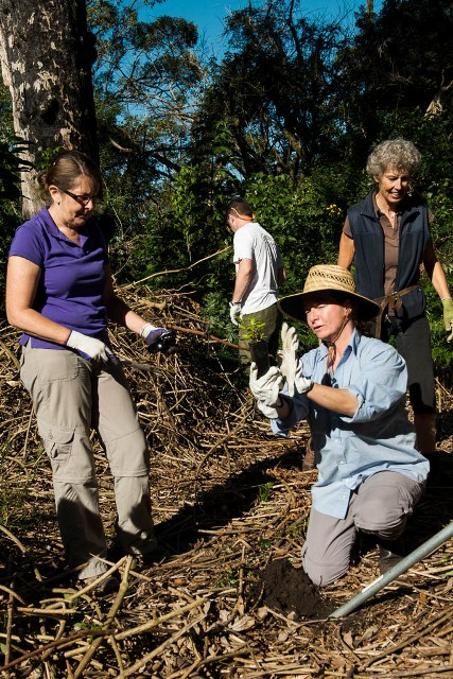 Mullet Creek BushcareThe first meeting of our new Mullet Creek bushcare group last weekend was a great success. Just below the Irrawong waterfall we planted about 120 trees and shrubs and put up a wire fence to keep them safe from the local swamp wallabies.
Mullet Creek BushcareThe first meeting of our new Mullet Creek bushcare group last weekend was a great success. Just below the Irrawong waterfall we planted about 120 trees and shrubs and put up a wire fence to keep them safe from the local swamp wallabies.
Some familiar bushcarers were there, but also many local people. For many of them this was a new experience.
The weather was perfect, the waterfall was roaring, Scarlet Honeyeaters were chirping high up in the Swamp Mahoganies, now coming into bloom. The afternoon tea was magnificent too.
A Large Project grant to Pittwater Environment Foundation from NSW Environment Trust is funding six years of bush regeneration and fauna monitoring in the Upper Mullet Creek area. Pittwater Council is a partner in this project.
If you would like to join this project, by helping with bushcare, or making a tax deductible donation, contact pittenvfound@gmail.com
www.pittwaterenvironmentfoundation.org.au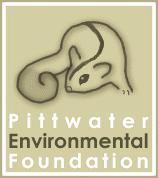
Photo above of Ann Miller, Helena Dewiss and Lesley Stevens by Michael Mannington.
